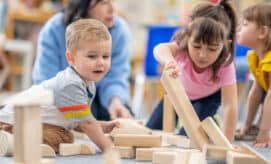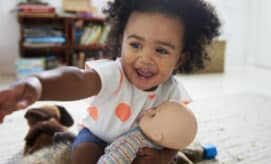Developmental Implications
From birth, infants are born as social beings, looking to their caregivers for comfort and interaction. An article in Psychological Science shares that “Babies can imitate behavior two to three weeks after they’re born…In the first months and years of life, babies realize that other people are like them…Over time, babies learn that they can act with intent and variety. They experience the ability to perform an action differently from the person they are imitating. Eventually they realize internal states, such as desire; further down the line they develop empathy.”
This means that even during the earliest weeks of life, infants are learning foundational social-emotional skills from their caregivers, such as how to communicate, express needs, and share in emotions. These experiences become the foundation for children’s ongoing development of social and relationship-building skills.
Supporting Children in Your Care
When caregivers engage in back and forth exchanges with infants, they are fueling infant learning! Child development and education expert, Alice Maclaine explains:
“The way that a baby develops socially is very much dependent on how they are responded to. If you are receptive and spend time talking to and copying each other, your baby will learn to be more animated. If he is rewarded with a smile and a clap from you, then he will be more likely to use the same behaviour again. Each time he repeats and copies your actions and noises he is laying down neural pathways. This is why repetition, copying, and imitation are so crucial to your baby’s development.”
Playing simple games with infants will provide opportunities for them to try new skills, such as…
-
rolling a ball on the ground and encouraging the child to roll it back towards you
-
taking turns copying gestures and facial expressions, such as clapping, sticking out your tongue, blowing kisses, or waving
-
for toddlers or older infants who are more mobile, singing songs with simple gestures for them to copy, such as “Head, Shoulders, Knees, and Toes”






